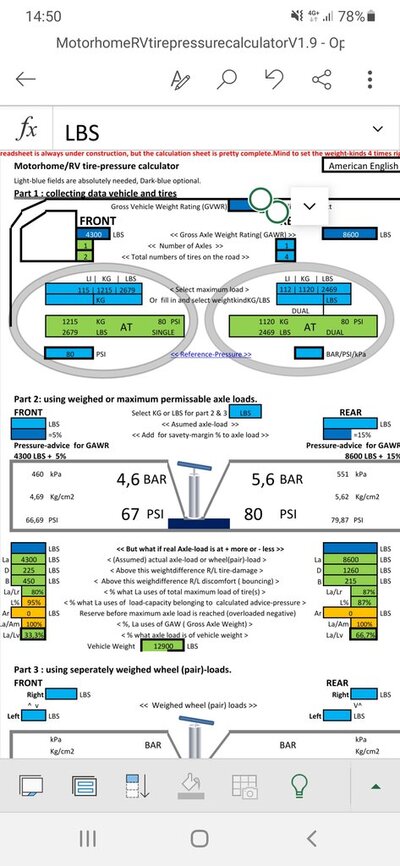JudyJB
Well-known member
You have the same size tires as I do: 225/75/R16
The reason I mention tire pressure is that I have had to argue with several RV service places about pressure. The Fleetwood sticker inside my motorhome says 75 in front and 80 in rear, but I had a guy in a very small RV repair place try to tell me that his friend who worked in a bigger dealership told him that the correct pressure in a motorhome tire was 65 pounds! That is ridiculous for a lot of reasons, the biggest of which is that motorhomes are NOT all the same size or weight or use the same tires.
I have also had a couple of instances where the mechanic I was asking to check the pressure in my tires would run around looking for the sticker on my driver's side door for the correct Ford manufacturer's tire pressure. I told him that any sticker there was put on by Ford BEFORE Fleetwood installed a motorhome on top of the bare chassis, and that the correct pressure was on the inside sticker. I went as far as taking a photo of the Fleetwood sticker because this guy thought he was arguing with a stupid woman, and i was losing patience. I was about to walk out and get air put in elsewhere!
My point is to find the correct pressure and don't let someone assume you don't know anything.
I now own a TPM (tire pressure monitor) device which tells me the pressure and temperature of each of my tires while I am driving.
The reason I mention tire pressure is that I have had to argue with several RV service places about pressure. The Fleetwood sticker inside my motorhome says 75 in front and 80 in rear, but I had a guy in a very small RV repair place try to tell me that his friend who worked in a bigger dealership told him that the correct pressure in a motorhome tire was 65 pounds! That is ridiculous for a lot of reasons, the biggest of which is that motorhomes are NOT all the same size or weight or use the same tires.
I have also had a couple of instances where the mechanic I was asking to check the pressure in my tires would run around looking for the sticker on my driver's side door for the correct Ford manufacturer's tire pressure. I told him that any sticker there was put on by Ford BEFORE Fleetwood installed a motorhome on top of the bare chassis, and that the correct pressure was on the inside sticker. I went as far as taking a photo of the Fleetwood sticker because this guy thought he was arguing with a stupid woman, and i was losing patience. I was about to walk out and get air put in elsewhere!
My point is to find the correct pressure and don't let someone assume you don't know anything.
I now own a TPM (tire pressure monitor) device which tells me the pressure and temperature of each of my tires while I am driving.

